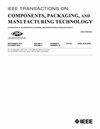新型可调 LED,板载芯片散热性能更佳
IF 2.3
3区 工程技术
Q2 ENGINEERING, ELECTRICAL & ELECTRONIC
IEEE Transactions on Components, Packaging and Manufacturing Technology
Pub Date : 2024-09-10
DOI:10.1109/TCPMT.2024.3456768
引用次数: 0
摘要
本文设计了一种新型可调式 LED 芯片板载 (COB) 模块,可根据用户的活动调节色温,使其成为暖色或白色照明。对 LED 在金属芯上的分布进行分析,以确定运行期间的适当工作温度。通过增大金属芯上芯片之间的间隙,增加了对流的暴露面积,从而实现了热量的改善。此外,根据在积分球中进行的光度测试,实现了均匀的照明分布。我们提出了一个数值模型,并使用有限元法(FEM)进行求解,以预测 COB LED 的温度分布。随后,制造了 COB 模块的原型,以便在运行期间进行测量和性能测试。测量使用红外(IR)相机和热电偶来获取温度曲线,并确定运行过程中的关键热点。数值模型经过验证,确认是评估预测温度模型的可靠工具。原型符合可靠运行所需的所有热参数和光度参数。本文章由计算机程序翻译,如有差异,请以英文原文为准。
New Tunable LED With Improved Heat Dissipation on Chip-on-Board
In this article, a new tunable LED chip-on-board (COB) module is designed, providing the opportunity to adjust the color temperature for warm or white lighting, depending on the activities carried out by the users. The distribution of LEDs on the metal core is analyzed to determine an appropriate operating temperature during operation. This thermal improvement is achieved by increasing the gap between the die chips on the metal core, which allows for an increased exposed area for convection. In addition, uniform lighting distribution is achieved in accordance with photometric tests conducted in an integrating sphere. A numerical model is proposed and solved using the finite element method (FEM) to predict the temperature distribution over the COB LED. Subsequently, a prototype of the COB module is manufactured to perform measurements and test its performance during operation. The measurements are conducted using an infrared (IR) camera and thermocouples to obtain temperature profiles and identify critical hot spots during operation. The numerical model is validated and confirmed to be a reliable tool for evaluating predicted temperature models. The prototype meets all the thermal and photometric parameters required for reliable operation.
求助全文
通过发布文献求助,成功后即可免费获取论文全文。
去求助
来源期刊

IEEE Transactions on Components, Packaging and Manufacturing Technology
ENGINEERING, MANUFACTURING-ENGINEERING, ELECTRICAL & ELECTRONIC
CiteScore
4.70
自引率
13.60%
发文量
203
审稿时长
3 months
期刊介绍:
IEEE Transactions on Components, Packaging, and Manufacturing Technology publishes research and application articles on modeling, design, building blocks, technical infrastructure, and analysis underpinning electronic, photonic and MEMS packaging, in addition to new developments in passive components, electrical contacts and connectors, thermal management, and device reliability; as well as the manufacture of electronics parts and assemblies, with broad coverage of design, factory modeling, assembly methods, quality, product robustness, and design-for-environment.
 求助内容:
求助内容: 应助结果提醒方式:
应助结果提醒方式:


